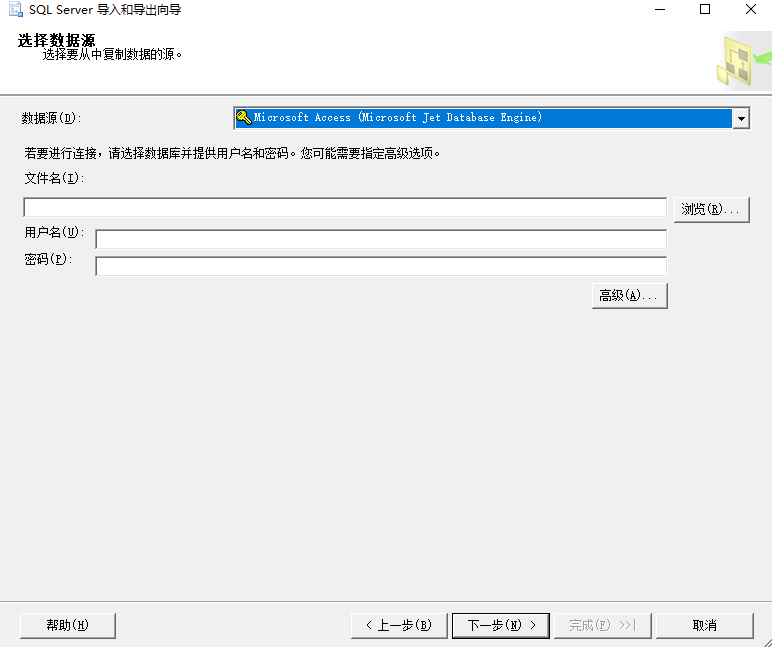可以将文章内容翻译成中文,广告屏蔽插件可能会导致该功能失效(如失效,请关闭广告屏蔽插件后再试):
问题:
I have a .sql file with an export from phpMyAdmin. I want to import it into a different server using the command line.
I have a Windows Server 2008 R2 installation. I placed the .sql file on the C drive, and I tried this command
database_name < file.sql
It is not working I get syntax errors.
- How can I import this file without a problem?
- Do I need to create a database first?
回答1:
Try:
mysql -u username -p database_name < file.sql
Check MySQL Options.
Note-1: It is better to use the full path of the SQL file file.sql.
Note-2: Use -R and --triggers to keep the routines and triggers of original database. They are not copied by default.
Note-3 You may have to create the (empty) database from mysql if it doesn\'t exist already and the exported SQL don\'t contain CREATE DATABASE (exported with --no-create-db or -n option), before you can import it.
回答2:
A common use of mysqldump is for making a backup of an entire database:
shell> mysqldump db_name > backup-file.sql
You can load the dump file back into the server like this:
UNIX
shell> mysql db_name < backup-file.sql
The same in Windows command prompt:
mysql -p -u [user] [database] < backup-file.sql
PowerShell
C:\\> cmd.exe /c \"mysql -u root -p db_name < backup-file.sql\"
MySQL command line
mysql> use db_name;
mysql> source backup-file.sql;
回答3:
Regarding the time taken for importing huge files: most importantly, it takes more time because the default setting of MySQL is autocommit = true. You must set that off before importing your file and then check how import works like a gem.
You just need to do the following thing:
mysql> use db_name;
mysql> SET autocommit=0 ; source the_sql_file.sql ; COMMIT ;
回答4:
Among all the answers, for the problem above, this is the best one:
mysql> use db_name;
mysql> source file_name.sql;
回答5:
We can use this command to import SQL from command line:
mysql -u username -p password db_name < file.sql
For example, if the username is root and password is password. And you have a database name as bank and the SQL file is bank.sql. Then, simply do like this:
mysql -u root -p password bank < bank.sql
Remember where your SQL file is. If your SQL file is in the Desktop folder/directory then go the desktop directory and enter the command like this:
~ ? cd Desktop
~/Desktop ? mysql -u root -p password bank < bank.sql
And if your are in the Project directory and your SQL file is in the Desktop directory. If you want to access it from the Project directory then you can do like this:
~/Project ? mysql -u root -p password bank < ~/Desktop/bank.sql
回答6:
- Open the MySQL command line
- Type the path of your mysql bin directory and press Enter
- Paste your SQL file inside the
bin folder of mysql server.
- Create a database in MySQL.
- Use that particular database where you want to import the SQL file.
- Type
source databasefilename.sql and Enter
- Your SQL file upload successfully.
回答7:
If you already have the database use the following to import the dump or the sql file
mysql -u username -p database_name < file.sql
if you don\'t you need to create the relevant database(empty) in MySQL, for that first log on to the MySQL console by running the following command in terminal or in cmd
mysql -u userName -p;
and when prompted provide the password.
Next create a database and use it
mysql>create database yourDatabaseName;
mysql>use yourDatabaseName;
Then import the sql or the dump file to the database from
mysql> source pathToYourSQLFile;
Note: if your terminal is not in the location where the dump or sql file exists, use the relative path in above.
回答8:
A solution that worked for me is below:
Use your_database_name;
SOURCE path_to_db_sql_file_on_your_local;
回答9:
Go to the directory where you have the MySQL executable. -u for username and -p to prompt for the password:
C:\\xampp\\mysql\\bin>mysql -u username -ppassword databasename < C:\\file.sql
回答10:
To import a single database, use the following command.
mysql -u username -p password dbname < dump.sql
To import multiple database dumps, use the following command.
mysql -u username -p password < dump.sql
回答11:
I think it\'s worth mentioning that you can also load a gzipped (compressed) file with zcat like shown below:
zcat database_file.sql.gz | mysql -u username -p -h localhost database_name
回答12:
To dump a database into a SQL file use the following command
mysqldump -u username -p database_name > database_name.sql
To import a SQL file into a database (make sure you are in the same directory as the SQL file or supply the full path to the file)
mysql -u username -p database_name < database_name.sql
回答13:
mysql --user=[user] --password=[password] [database] < news_ml_all.sql
回答14:
For importing multiple SQL files at one time, use this:
# Unix-based solution
for i in *.sql;do mysql -u root -pPassword DataBase < $i;done
For simple importing:
# Unix-based solution
mysql -u root -pPassword DataBase < data.sql
For WAMP:
#mysqlVersion replace with your own version
C:\\wamp\\bin\\mysql\\mysqlVersion\\bin\\mysql.exe -u root -pPassword DataBase < data.sql
For XAMPP:
C:\\xampp\\mysql\\bin\\mysql -u root -pPassword DataBase < data.sql
回答15:
You do not need to specify the name of the database on the command line if the .sql file contains CREATE DATABASE IF NOT EXISTS db_name and USE db_name statements.
Just make sure you are connecting with a user that has the permissions to create the database, if the database mentioned in the .sql file does not exist.
回答16:
Easiest way to import into your schema:
Login to mysql and issue below mention commands.
mysql> use your_db_name;
mysql> source /opt/file.sql;
回答17:
Import a database
Go to drive:
command: d:
MySQL login
command: c:\\xampp\\mysql\\bin\\mysql -u root -p
It will ask for pwd. Enter it:
pwd
Select the database
use DbName;
Provide the file name
\\.DbName.sql
回答18:
Add the --force option:
mysql -u username -p database_name --force < file.sql
回答19:
Go to the directory where you have MySQL.
c:\\mysql\\bin\\> mysql -u username -p password database_name <
filename.sql
Also to dump all databases, use the -all-databases option, and no databases’ name needs to be specified anymore.
mysqldump -u username -ppassword –all-databases > dump.sql
Or you can use some GUI clients like SQLyog to do this.
回答20:
I thought it could be useful for those who are using Mac OS X:
/Applications/xampp/xamppfiles/bin/mysql -u root -p database < database.sql
Replace xampp with mamp or other web servers.
回答21:
The following command works for me from the command line (cmd) on
Windows 7 on WAMP.
d:/wamp/bin/mysql/mysql5.6.17/bin/mysql.exe -u root -p db_name < database.sql
回答22:
Sometimes the port defined as well as the server IP address of that database also matters...
mysql -u user -p user -h <Server IP> -P<port> (DBNAME) < DB.sql
回答23:
For backup purposes, make a BAT file and run this BAT file using Task Scheduler. It will take a backup of the database; just copy the following line and paste in Notepad and then save the .bat file, and run it on your system.
@echo off
for /f \"tokens=1\" %%i in (\'date /t\') do set DATE_DOW=%%i
for /f \"tokens=2\" %%i in (\'date /t\') do set DATE_DAY=%%i
for /f %%i in (\'echo %date_day:/=-%\') do set DATE_DAY=%%i
for /f %%i in (\'time /t\') do set DATE_TIME=%%i
for /f %%i in (\'echo %date_time::=-%\') do set DATE_TIME=%%i
\"C:\\Program Files\\MySQL\\mysql server 5.5\\bin\\mysqldump\" -u username -ppassword mysql>C:/%DATE_DAY%_%DATE_TIME%_database.sql
回答24:
I kept running into the problem where the database wasn\'t created.
I fixed it like this
mysql -u root -e \"CREATE DATABASE db_name\"
mysql db_name --force < import_script.sql
回答25:
While most answers here just mention the simple command
mysql -u database_user -p [db_name] < database_file.sql
today it\'s quite common that databases and tables have utf8-collation where this command is not sufficient.
Having utf8-collation in the exported tables it\'s required to use this command:
mysql -u database_user -p --default-character-set=utf8 [db_name] < database_file.sql
Surley this works for other charsets too, how to show the right notation can be seen here:
https://dev.mysql.com/doc/refman/5.7/en/show-collation.html
One comment mentioned also that if a database never exists an empty database had to be created first. This might be right in some cases, but depends on the export file. If the exported file includes already the command to create the database then the database never has to be created in a separated step, which even could cause an error on import. So on import it\'s advisable to have a look first in the file to know which commands are included there, on export it\'s advisable note the settings, especially if the file is very large and hard to read in an editor.
There are still more parameters for the command which are listed and explained here:
https://dev.mysql.com/doc/refman/5.7/en/mysql-command-options.html
If you use another database-version consider searching for the corresponding version of the manual too. The mentioned links refer to MySQL version 5.7.
回答26:
The following steps help to upload file.sql to the MySQL database.
Step 1: Upload file.sql.zip to any directory and unzip there
Note: sudo apt-get install unzip
: sudo apt-get unzip file.sql.zip
Step 2: Now navigate to that directory. Example: cd /var/www/html
Step 3: mysql -u username -p database-name < file.sql
Enter the password and wait till uploading is completed.
回答27:
For information I just had default root + withoutpassword, it didn\'t works with all above answers.
回答28:
I\'m using Windows 10 with Powershell 5 and I found almost all \"unix-like\" solutions not working for me.
> mysql -u[username] [database-name] < my-database.sql
At line:1 char:31
+ mysql -u[username] [database-name] < my-database.sql
+ ~
The \'<\' operator is reserved for future use.
+ CategoryInfo : ParserError: (:) [], ParentContainsErrorRecordException
+ FullyQualifiedErrorId : RedirectionNotSupported
I ends up using this command.
> type my-database.sql | mysql -u[username] -h[localhost] -p [database-name]
and it works perfectly, hopefully it helps.
Thanks to @Francesco Casula\'s answer btw.
回答29:
Similarly to https://stackoverflow.com/a/17666285/1888983
Key differences for me:
- The database has to exist first
- No space between
-p and the password
shell> mysql -u root -ppassword #note: no space between -p and password
mysql> CREATE DATABASE databasename;
mysql> using databasename;
mysql> source /path/to/backup.sql
Running fedora 26 with MariaDB.
回答30:
mysql -u root -p password -D database_name << import.sql
Use mysql help for details mysql --help
I think these will be useful options in our context
[~]$ mysql --help
mysql Ver 14.14 Distrib 5.7.20, for osx10.12 (x86_64) using EditLine wrapper
Copyright (c) 2000, 2017, Oracle and/or its affiliates. All rights reserved.
Usage: mysql [OPTIONS] [database]
-?, --help Display this help and exit.
-I, --help Synonym for -?
--bind-address=name IP address to bind to.
-D, --database=name Database to use.
--delimiter=name Delimiter to be used.
--default-character-set=name Set the default character set.
-f, --force Continue even if we get an SQL error.
-p, --password[=name] Password to use when connecting to server.
-h, --host=name Connect to host.
-P, --port=# Port number to use for connection or 0 for default to, in order of preference, my.cnf, $MYSQL_TCP_PORT, /etc/services, built-in default (3306).
--protocol=name The protocol to use for connection (tcp, socket, pipe,
-s, --silent Be more silent. Print results with a tab as separator, each row on new line.
-v, --verbose Write more. (-v -v -v gives the table output format).
-V, --version Output version information and exit.
-w, --wait Wait and retry if connection is down.
what is fun, if we are importing a large database and not having a progress bar. Use Pipe Viewer and see the data transfer through the pipe
For Mac, brew install pv
.For Debian/Ubuntu, apt-get install pv.
Others, refer http://www.ivarch.com/programs/pv.shtml
pv import.sql | mysql -u root -p password -D database_name
1.45GiB 1:50:07 [339.0KiB/s] [=============> ] 14% ETA 11:09:36
1.46GiB 1:50:14 [ 246KiB/s] [=============> ] 14% ETA 11:09:15
1.47GiB 1:53:00 [ 385KiB/s] [=============> ] 14% ETA 11:05:36



